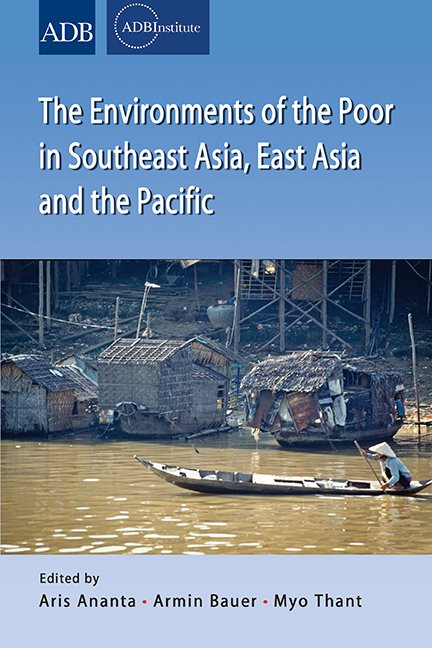Book contents
- Frontmatter
- Contents
- Preface
- List of Contributors
- Part I OVERVIEW
- Part II EAST ASIA (People's Republic of China and Republic of Korea)
- Part III PACIFIC ISLANDS
- Part IV MAINLAND SOUTHEAST ASIA (Cambodia, Thailand, Vietnam)
- 9 Poverty and the Environment in Rural Cambodia
- 10 Conservation Agriculture in Cambodia: A Triple-Win Option
- 11 Voices of the Poor on Climate Change in Thailand and Vietnam
- 12 Poor Thai Farmers' Adaptation to Climate Change
- Part V ARCHIPELAGIC SOUTHEAST ASIA (Indonesia, Malaysia, Philippines)
9 - Poverty and the Environment in Rural Cambodia
from Part IV - MAINLAND SOUTHEAST ASIA (Cambodia, Thailand, Vietnam)
Published online by Cambridge University Press: 21 October 2015
- Frontmatter
- Contents
- Preface
- List of Contributors
- Part I OVERVIEW
- Part II EAST ASIA (People's Republic of China and Republic of Korea)
- Part III PACIFIC ISLANDS
- Part IV MAINLAND SOUTHEAST ASIA (Cambodia, Thailand, Vietnam)
- 9 Poverty and the Environment in Rural Cambodia
- 10 Conservation Agriculture in Cambodia: A Triple-Win Option
- 11 Voices of the Poor on Climate Change in Thailand and Vietnam
- 12 Poor Thai Farmers' Adaptation to Climate Change
- Part V ARCHIPELAGIC SOUTHEAST ASIA (Indonesia, Malaysia, Philippines)
Summary
In Cambodia, the poor depend largely on natural resources for their livelihoods. This is particularly true for the rural poor. Hence, decline in the quality and accessibility of natural resources due to climate change is likely to affect them more seriously than the non-poor. Specifically, the poor become more vulnerable because they are less able to adapt to environmental change. Despite the fragility of Cambodian politics in the 1990s, the economy grew at a remarkable 7.2 per cent (average). After political stability returned in 1999, the rate rose even higher — to an average of 9.3 per cent for 2000–08. This resulted in an increase in per capita income and a decline in poverty. According to the latest World Bank Poverty Assessment report, the poverty headcount in Cambodia declined from 47 per cent in 1993/94 to 30 per cent in 2007. During the same period, school enrolment, housing, and access to safe drinking water, electricity, and sanitation also improved (MOP 2006; World Bank 2009).
Despite this impressive performance, poverty rate was not uniform across the country. Poverty rates are higher in rural areas than in urban areas in all geographical zones (MOP 2006). Of the country's five geographical zones, Plateau and Mountains is the poorest, with a poverty rate of 52 per cent in 2004, followed by Tonle Sap (42 per cent), Plains (32 per cent), Coastal regions (27 per cent), and Phnom Penh (4.6 per cent). Since the Tonle Sap zone, has so many poor, and contains 30 per cent of Cambodia's population (MOP 2009), it has become of special concern to policy makers and other national and international stakeholders. The Participatory Poverty Assessment of the Tonle Sap region conducted by the Cambodian Development Resource Institute (2007) reveals that the poor there have benefited less from Cambodia's rapid economic growth than the non-poor. The poor of this zone are still heavily dependent on land- and water-based natural resources for their livelihoods.
- Type
- Chapter
- Information
- Publisher: ISEAS–Yusof Ishak InstitutePrint publication year: 2013



